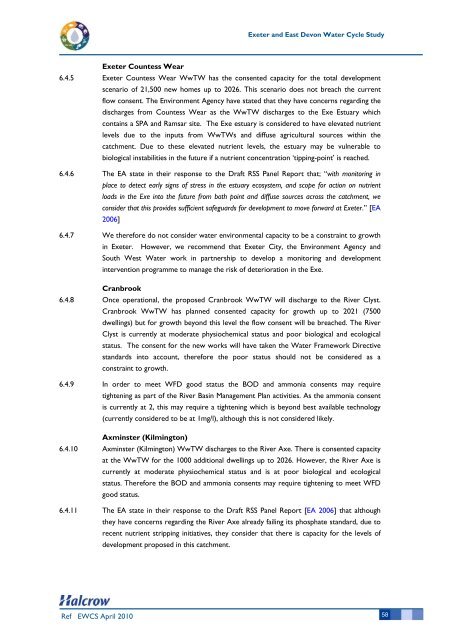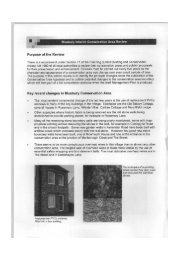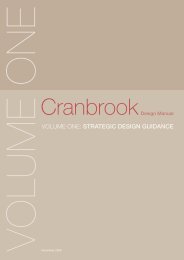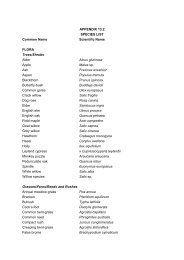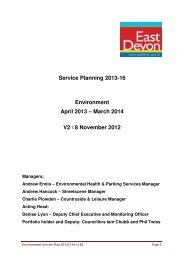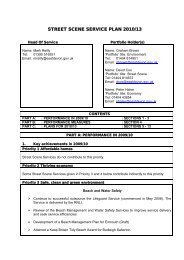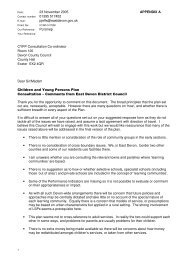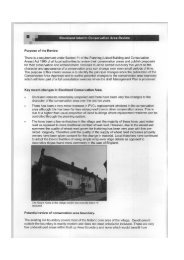Water Cycle Study - East Devon District Council
Water Cycle Study - East Devon District Council
Water Cycle Study - East Devon District Council
Create successful ePaper yourself
Turn your PDF publications into a flip-book with our unique Google optimized e-Paper software.
Ref EWCS April 2010<br />
Exeter and <strong>East</strong> <strong>Devon</strong> <strong>Water</strong> <strong>Cycle</strong> <strong>Study</strong><br />
Exeter Countess Wear<br />
6.4.5 Exeter Countess Wear WwTW has the consented capacity for the total development<br />
scenario of 21,500 new homes up to 2026. This scenario does not breach the current<br />
flow consent. The Environment Agency have stated that they have concerns regarding the<br />
discharges from Countess Wear as the WwTW discharges to the Exe Estuary which<br />
contains a SPA and Ramsar site. The Exe estuary is considered to have elevated nutrient<br />
levels due to the inputs from WwTWs and diffuse agricultural sources within the<br />
catchment. Due to these elevated nutrient levels, the estuary may be vulnerable to<br />
biological instabilities in the future if a nutrient concentration ‘tipping-point’ is reached.<br />
6.4.6 The EA state in their response to the Draft RSS Panel Report that; “with monitoring in<br />
place to detect early signs of stress in the estuary ecosystem, and scope for action on nutrient<br />
loads in the Exe into the future from both point and diffuse sources across the catchment, we<br />
consider that this provides sufficient safeguards for development to move forward at Exeter.” [EA<br />
2006]<br />
6.4.7 We therefore do not consider water environmental capacity to be a constraint to growth<br />
in Exeter. However, we recommend that Exeter City, the Environment Agency and<br />
South West <strong>Water</strong> work in partnership to develop a monitoring and development<br />
intervention programme to manage the risk of deterioration in the Exe.<br />
Cranbrook<br />
6.4.8 Once operational, the proposed Cranbrook WwTW will discharge to the River Clyst.<br />
Cranbrook WwTW has planned consented capacity for growth up to 2021 (7500<br />
dwellings) but for growth beyond this level the flow consent will be breached. The River<br />
Clyst is currently at moderate physiochemical status and poor biological and ecological<br />
status. The consent for the new works will have taken the <strong>Water</strong> Framework Directive<br />
standards into account, therefore the poor status should not be considered as a<br />
constraint to growth.<br />
6.4.9 In order to meet WFD good status the BOD and ammonia consents may require<br />
tightening as part of the River Basin Management Plan activities. As the ammonia consent<br />
is currently at 2, this may require a tightening which is beyond best available technology<br />
(currently considered to be at 1mg/l), although this is not considered likely.<br />
Axminster (Kilmington)<br />
6.4.10 Axminster (Kilmington) WwTW discharges to the River Axe. There is consented capacity<br />
at the WwTW for the 1000 additional dwellings up to 2026. However, the River Axe is<br />
currently at moderate physiochemical status and is at poor biological and ecological<br />
status. Therefore the BOD and ammonia consents may require tightening to meet WFD<br />
good status.<br />
6.4.11 The EA state in their response to the Draft RSS Panel Report [EA 2006] that although<br />
they have concerns regarding the River Axe already failing its phosphate standard, due to<br />
recent nutrient stripping initiatives, they consider that there is capacity for the levels of<br />
development proposed in this catchment.<br />
58


